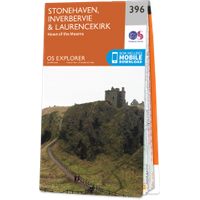Glenfarquhar Castle
All that remains of Glenfarquhar Castle is part of the moat around where it originally stood, and three sides of a rectilinear enclosure, situated 120m south-west of Mains of Glenfarquhar farmhouse.
Little is known about the early origins of Glenfarquhar Castle, sometimes also known as Kintore Castle, but the lands of Glenfarquhar were granted by William the Lion to Humphrey de Berkeley, or Humphry Barclay, in the late 12th century.
Humphrey’s daughter, Richenda, seems to have given Glenfarquhar to Arbroath Abbey in 1246, upon the death of her husband. However following her death she was succeeded by her uncle John de Berkeley, Humphrey’s brother, who took back the Glenfarquhar from the monks.
By the mid-17th century the lands of Glenfarquhar were owned by the Falconers of Haulkerton, whose origins in the area also go back to the time of William the Lion. A Sir David Falconer seems to be the first recorded Falconer of Glenfarquhar, appearing in the Records of the Parliament of Scotland as early as 1643.
Sir David’s eldest son, Sir Alexander, was created a baronet in 1671, and interestingly there is a stone carved with the date 1671 installed in the south west wall of the steading at Mains of Glenfarquhar. It may be that as Sir Alexander’ status in society rose, he added to, or rebuilt Glenfarquhar Castle.
A second stone inscribed SAF 1674 DHG (presumably for Sir Alexander Falconer and his wife Margaret Graeme – the DHG may actually be DMG for Dame Margaret Graeme) has since been lost, and several other stones from the castle are said to be incorporated within Mains of Glenfarquhar.
One of Sir Alexander’s nieces, Catherine Falconer, married into the Hume family and was the mother of David Hume.
In 1724, Glenfarquhar passed to another Alexander Falconer, when it was incorporated into the Haulkerton estate upon the death of David, the 3rd Lord Falconer.
It seems that at this time the focus switched from Glenfarquhar to Haulkerton, as Alexander, who was to be the 4th Lord Falconer for just 3 years, died in 1727 without any children, and he was described as the last in the main line of the Falconers of Glenfarquhar and the last to live at the Castle of Haulkerton.
The focus of the Haulkerton estate then seems to have switched to Inglismaldie Castle, as Alexander’s cousin, David Falconer, the 5th Lord Falconer, died at Inglismaldie in 1751.
In 1778 Anthony Adrian Falconer, the 8th Lord Falconer, succeeded to the estate of Kintore, becoming the 5th Earl of Kintore in the process. This is presumably where the name of Kintore Castle came from at Glenfarquhar.
Glenfarquhar Castle was evidently neglected over the following years, as by the mid-19th century the majority of the castle’s stones had been removed and used in building work.
The farm buildings of the Mains of Glenfarquhar are said to have been built in 1857 using the castle’s stones, and a stone with the date 1857 was installed above the stable door along with the 1674 date stone from the castle.
However, according to genealogical records the Mains of Glenfarquhar existed certainly as early as 1708 (when a John Burness is said to have been born there), so the date of 1857 may relate to later work. The 1674 and 1857 stones now seem to be lost, but the 1671 stone is built into the south west wall of the steading.
Today all that is left is part of the castle’s moat, including the whole of the north side and a section of the east side. The moat can also be traced on the west side, along which are the remains of the footings of a courtyard wall, what is left measuring approximately 6.0m in length.
The courtyard itself seems to have measured around 41.0m across, and the moat was around 7.0m wide and 1.0m deep.
Alternative names for Glenfarquhar Castle
Glenfarquar Castle; Kintore Castle
Where is Glenfarquhar Castle?
Glenfarquhar Castle is in the parish of Fordoun and the county of Kincardineshire.
Grid reference: NO 7179 8044
Lat / long: 56.91421451, -2.464838152










